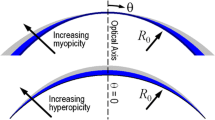Tribological conditions for contact lenses have very low contact pressures in the range 3–5 kPa and sliding speeds around 12 cm/s. Using a microtribometer a series of experiments was run on commercially available contact lenses made from Etafilcon-A. These tests were run using 10–50 mN of normal load at speeds from 63 to 6280 μm/s using a 1-mm radius glass sphere as a pin. The resulting contact pressures are believed to be nearly an order of magnitude larger than the targeted 3–5 kPa. It is hypothesized that the viscoelastic nature of the hydrogel, viscous shearing of the packaging solution, and interfacial shear between the glass sphere and the contact lens all contribute to the friction forces. A model that includes all three of these contributors is developed and compared to the experimental data. The experimental friction coefficients vary from μ = 0.025 to 0.075. The calculated fluid film␣thicknesses were between 1 and 30 nm. The average surface roughness of the lens and the glass sphere are Ra=15 nm and Ra=8 nm, respectively, suggesting that the contact is not in full elastohydrodynamic lubrication. Finally, the largest contributors to the friction force in these experiments were found to be viscous dissipation within the hydrogel and interfacial shear within the contact zone.
Similar content being viewed by others
References
D.K. Martin B.A. Holden (1986) Phys. Med. Biol. 31 635
C.W. McCutchen (1962) Wear 5 1
J.A. Nairn and T. Jiangizaire (1995), ANTEC ’95 3384
M.E. Freeman M.J. Furey B.J. Love J.M. Hampton (2000) Wear 241 129
G. Hung F. Hsu L. Stark (1977) Am. J. Optometr. Physiol. Optics 54 678
M.D. Pascovici T. Cicone (2003) Tribol. Int. 36 791
H.W. Liu B. Bhushan (2003) J. Vacuum Sci. Technol. A 21 1528
M. D.P. Willcox N. Harmis B.A. Cowell T. Williams B.A. Holden (2001) Biomaterials 22 3235
P. Podra S. Andersson (1997) Wear 207 79
J. Halling, T.L. Whomes, P.B. Davies and R.D. Arnell, Tribology: Principles and Design Applications (Springer Verlag, 1993).
B.J. Hamrock D. Dowson (1978) J. Lubricat. Technol.—Trans. Asme 100 236
S.H. Kim A. Opdahl C. Marmo G.A. Somorjai (2002) Biomaterials 23 1657
Author information
Authors and Affiliations
Rights and permissions
About this article
Cite this article
Rennie, A.C., Dickrell, P.L. & Sawyer, W.G. Friction coefficient of soft contact lenses: measurements and modeling. Tribol Lett 18, 499–504 (2005). https://doi.org/10.1007/s11249-005-3610-0
Received:
Accepted:
Issue Date:
DOI: https://doi.org/10.1007/s11249-005-3610-0




